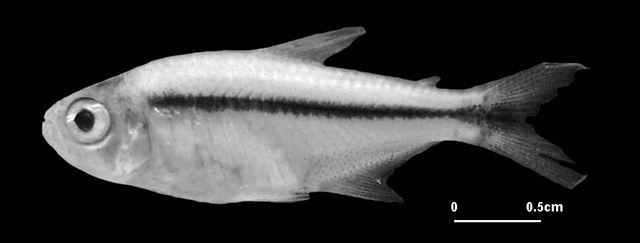| Characidae (Characins; tetras), subfamily: Stethaprioninae |
| 2.853 cm SL (male/unsexed) |
|
benthopelagic; freshwater |
| South America: known only from the type locality and small adjacent drainages in Lara state, northern Venezuela. |
|
Dorsal soft rays (total): 11-11; Anal soft rays: 23-24; Vertebrae: 32-32. The following characters separate this species from all other Venezuelan congeners: dorsal fin with three unbranched and eight branched rays, except in Hyphessobrycon notidanos, Hyphessobrycon oritoensis, Hyphessobrycon fernandezi; maxilla short; maxilla with one pentacuspid tooth; dentary with eight teeth; premaxilla with 2-3 teeth in the outer row; lateral scales 28-29; predorsal scales 9; no sexual dimorphism; dark lateral band extending from the upper rear margin o the opercle to the caudal peduncle and continuing as a rhomboidal peduncular blotch onto the middle caudal fin rays (Ref. 79635).
Description: D iii,8; A iii,20-21; P i- ii,10; V ii,7 (Ref. 79635). |
|
|
Endangered (EN); Date assessed: 17 May 2017 (B1ab(iii)+2ab(iii)) Ref. (130435)
|
| harmless |
Source and more info: www.fishbase.org. For personal, classroom, and other internal use only. Not for publication.

